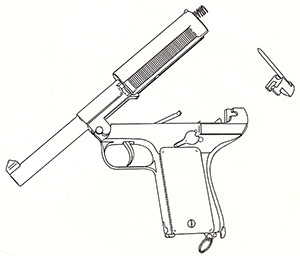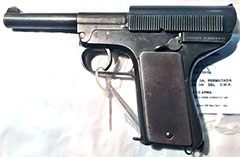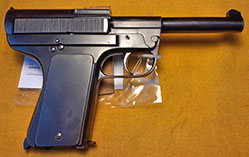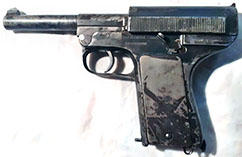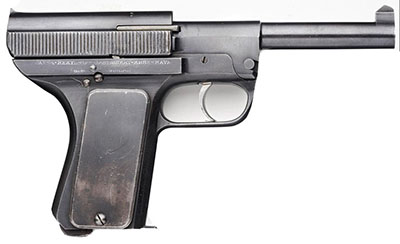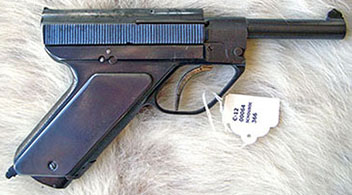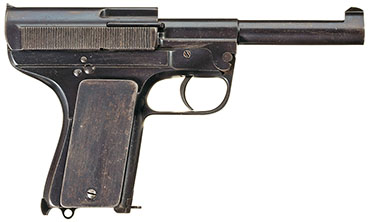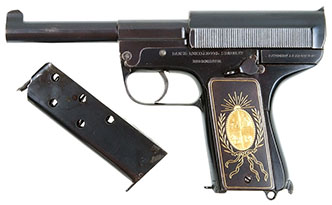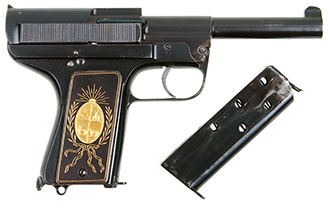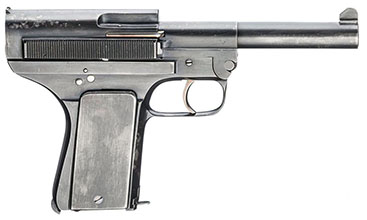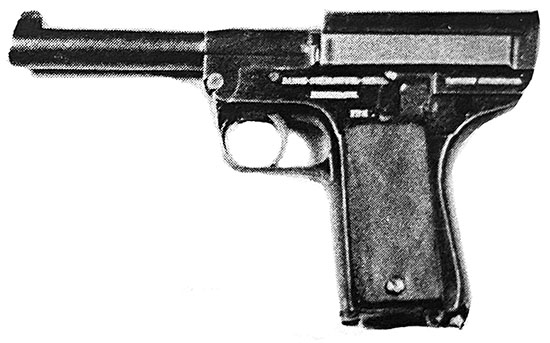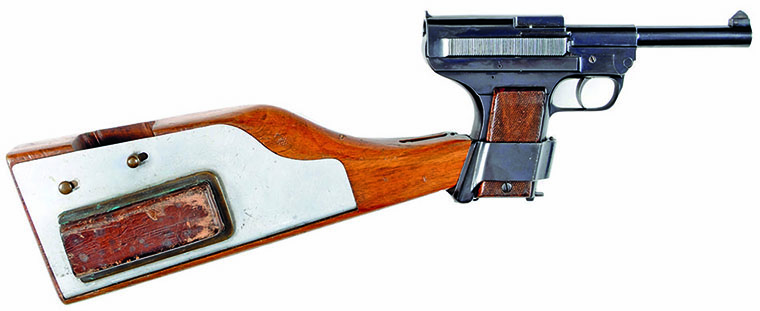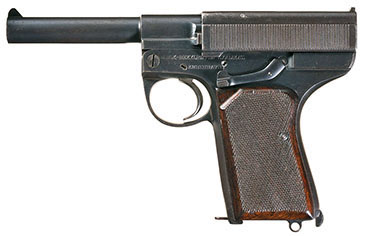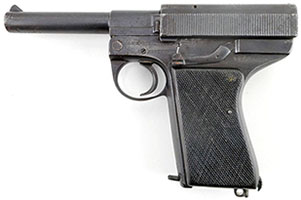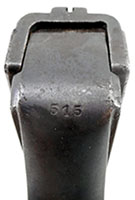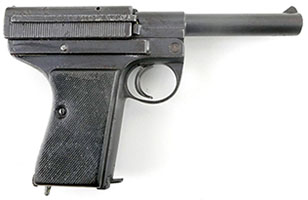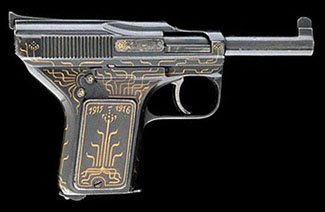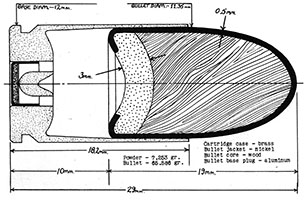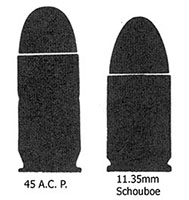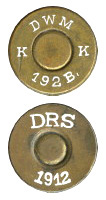 |
|||||||||||||||||||||||||||||||||||||||||||||||||||||||||||||||||||||||||||||||||||||||||||||||||||||||||||||||||||||||||||||||||||||||||||||||||||||||||||||||||||||||||||||||||||||||||||||||||||||||||||||||||||||||||||||||||||||||||||||||||||||||||||||||||||||||||||||||||||||||||||||||||||||||||||||||||||||||||||||||||||||||
|
The Schouboe Pistol, Continued Type III or Model of 1910
The third type of Schouboe pistol, which likely appeared around 1910 or 1911, is characterized by a truncated slide which does not extend out over the chamber of the barrel and which therefore requires no ejection port. The rear sight is integral with the slide. The extractor is now external and has been moved higher on the right side of the slide. The Type III has two external hooks beneath the barrel which engage a heavy pin or trunnion at the front of the frame, replacing the internal hook on the earlier types. The safety lever has been redesigned. It points forward, instead of to the rear, and in the up position it serves to lock the slide as well as the sear.
Serial numbers 359, 376, and 385 are grouped together because they are all in the same collection in Uruguay and have nearly identical features. Number 359 is the first gun observed with a new magazine release mechanism which is pressed forward from the rear to drop the magazine. The magazine is retained not at the rear but at the front. Note that the triangular-cut vertical slide serrations end just before the rear of the slide. All three guns are chambered for the 11.35mm Schouboe cartridge and have a milled area on the right side of the slide, just above the external extractor. These gun have a small lanyard on the base. The left side of the frame is stamped in all-capital serif characters as follows: DANSK-REKYLRIFFEL-SYNDIKAT. The reinforced area at the rear of the frame is stamped: PATENT SCHOUBOE
Serial number 361, which is in the Royal Armouries collection in England, has a 128mm (five inch) barrel, with an overall length of 225mm (8.86 inches), and weighs 1.195 kg. It is chambered for the 11.35mm cartridge. The gun differs from most other Type III pistols in that is has the earlier style magazine release that holds the magazine at the rear. Slide serrations extend all the way to the rear of the slide. Grip plates are of steel with a single screw at the bottom. Unlike most other Type III pistols, the inscription is on the right side of the frame, on the reinforced area beneath the slide, in all-capital serif characters as follows: DANSK REKYLRIFFEL-SYNDIKAT-KØBENHAVN
Serial number 366 is the only Schouboe pistol documented with a radically angled grip frame, even more pronounced than the P08 Parabellum. Other than the grip angle, though, it is a Type III, chambered for the 11.35mm Schouboe cartridge. The magazine holds six rounds. Slide serrations extend all the way to the rear of the slide. The gun is unmarked except for the serial number on the grip tang. Serial number 368 is pictured in Darel Magee’s 1974 Gun Collector’s Digest article entitled “Big Bore Blow-Back Auto Pistols,” and appears nearly identical to serial numbers 376 and 385 above, and 378 below.
Serial number 378 is chambered for the 11.35mm Schouboe cartridge, and the magazine holds 6 rounds. The barrel is 130mm (5.12 inches) long. Grip plates are of steel. Slide serrations do not extend to the end of the slide.
Serial number 382 is another gun with the Uruguayan crest on the grips, clearly intended as a presentation piece, and chambered for the 11.35mm Schouboe cartridge. Its dimensions are virtually the same as serial number 339, but it is a Type III instead of a Type II. Markings are the same as serial numbers 359, 376, 378, and 385.
Serial number 408 has a 122mm barrel, and is chambered for 11.35mm. It is different from previous Type III pistols only in that the inscription is in all-capital sans-serif characters as follows: DANSK REKYLRIFFEL SYNDIKAT The reinforced area at the rear of the frame is stamped: PATENT SCHOUBOE
Serial number 452 appeared on the cover of The Texas Gun Collector for October 1952. The reproduction is poor by today’s standards, but we can see enough to know the gun is virtually identical to serial number 455 below.
Serial number 455 is the only known specimen with a shoulder stock numbered to the gun. It is chambered in 11.35mm and has a 128mm (five inch) barrel. The gun has the same inscription as numbers 359, 376, 378, 382, and 385. It is one of two specimens observed with the fire position for the safety marked in French: “FEU.” Grip plates are of checkered wood with a single screw at the bottom. This gun is shown in Hogg & Weeks’ Pistols of the World where it is labeled as a Model 1907. Serial number 455 is also shown in the Standard Catalog of Firearms where it is labeled as a “Model 1910/12,” and the entry states that the gun “was involved in the U.S. Military tests in 1912” which is incorrect, as we will see below: the gun used in the U.S. tests was serial number 499, and it is of a different type. (I am referencing the 2005 version of the Standard Catalog, but the same statement appears in the 2009 and 2019 versions.) Bady states that three guns were made in 9mm Parabellum “...as an instructional exercise for apprentice toolmakers.” One is illustrated in the Standard Catalog of Firearms. It is a Type III pistol, identical in every way to the 11.35mm version. I doubt these guns would be safe to shoot, as the light slide and underpowered recoil spring would not support such a powerful cartridge. I do not know the serial numbers of the guns made in 9mm. Type IV or Model of 1912 U.S. Test of the Schouboe Pistol DRS contacted the U.S. Ordnance Department by letter on 14 June 1909, sending photographs of their 11.35mm pistol and sketches of the mechansim, and requesting that it be tested. The Ordnance Department responded favorably and DRS indicated it would send two pistols for testing, but apparently they were never sent. The ordnance department wrote DRS on 30 January 1912, after the Colt 1911 had already been accepted by the military for use as a service pistol, requesting a price quote. An 11.35mm Schouboe pistol and 1000 rounds of ammunition were ordered on 9 March 1912 and received on 22 August of the same year. The pistol and ammunition were tested on 13 January 2013. Edward Scott Meadows quotes the bottom line of the Ordnance Department report: “The pistol functioned satisfactorily during the entire test, but is not considered superior in any respect to our service pistol...”
The gun received by the ordnance department was serial number 499 (shown in Meadows’ U.S. Military Automatic Pistols: 1894-1920 on page 424, and in Matthews’ Firearms Identification Vol. I, page 270, and in Wilson’s Textbook of Automatic Pistols), and it is an entirely new design. The shape of the trigger guard is much more rounded, and the trigger itself has a stronger curve. The position of the trigger spring has been moved, and the entire lockwork is redesigned, with a new stirrup-shaped sear that pivots from the bottom and is tensioned by a flat spring, a redesigned hammer, and a hammer strut curved at the top. The transfer bar is on the right side. The safety lever extends toward the front, with two detents, down being the fire position, and up being the safe position, which also locks the slide. There is no mechanism to lock the slide when the last round is fired. The barrel is pinned to the frame, and tilts upward on the pin. The photograph of disassembled parts for this gun shows a rear latch for disassembly, as on earlier pistols. The top of the slide is flattened and squared off instead of being rounded. The extractor has been moved to the top of the gun, slightly toward the right side, and also serves as a loaded-chamber indicator, as shown in the drawing above. The magazine baseplate extends to the rear as well as to the front. The Ordnance Department report indicates that the loaded magazine was difficult to insert. Grip plates are of checkered walnut, held by a single screw through the frame at the rear.
Serial number 502 has a 115mm barrel and is chambered for the 11.35mm cartridge. Grips are of checkered walnut. It appears identical to the 1912 test pistol serial number 499, except that it has a screw or screws in place of the pin to hold the barrel in the frame. The gun is marked on the left side of the frame, above the trigger guard, in all-capital serif characters as follows: DANSK-REKYLRIFFEL-SYNDIKAT. Type V or Model of 1916 Donald Bady states: “The last 11.35 mm. pistol was the Model 1916, produced in small quantity a year before Schouboe retired from DRS. In all, no more than six hundred 11.35 mm. Schouboe pistols were manufactured between 1904 and 1917.” A pistol is shown in the Standard Catalog of Firearms and marked as a “Model 1916.” It is indistinguishable from Type IV pistols like serial numbers 499 and 502, but only the left side is shown.
Serial number 515 is chambered for the 11.35mm cartridge. It has a pin holding the barrel to the frame. There is no latch at the rear of the slide, and there is a horizontal bar across the top of the slide serrations on the right side. I do not know how this gun disassembles. Markings are the same as the previous gun. This is the highest serial number I have observed, and the only one of this type. Outlier
This gun with a 90mm (3.5 inch) barrel is chambered for the 7.65mm Browning cartridge. It has the slide characteristics of a “Type 32” pistol, but is the only 7.65mm pistol documented with the forward-pointing safety lever of a Type III. It also retains the locking plate for the hammer and sear pins on the right side. The gun is inlaid with gold markings and decorations, including “Fyr” and “Sikker” beneath the safety lever. The left steel grip plate is marked with an “A.E.B.” monogram, and the right grip has the date 1915-1916. The auction listing for this gun states the serial number is 65, but no photograph of the serial number is shown. It seems likely that parts for this gun were made earlier than the date on the grips, and the gun was assembled and/or refurbished in 1915 or 1916 as a gift or award. Conclusion Donald Bady states that less than 600 Schouboe pistols were made in 11.35mm, though the true figure for 11.35mm may be considerably less than 600, probably closer to 400. The serial numbers I have documented for all Schouboe pistols only run from 65 through 515. It is very likely that most Schouboe pistols were made before the first world war, between the years 1902 and 1913, though I take Donald Bady’s contention seriously that a few were made as late as 1916. I assume that serial number 515 is one such pistol, though it is only sixteen digits away from number 499 which we know dates from about 1912. Denmark was technically neutral during World War I, but the Madsen light machine gun was still being manufactured, along with other cast metal products, and it seems likely that DRS might have been preoccupied with products other than the Schouboe pistol during the war. According to Hogg & Weeks, Jens Schouboe left DRM in 1917, which also tallies with information provided by Bady. Bady, quoting a DISA official in 1959, says: “...[the Schouboe pistol] has been given for several years as a prize to the best marksman among the cadets of the year...” And in their summary regarding the Schouboe Hogg & Weeks also state: “...the pistols produced were distributed for military trials, as graduation and marksmanship awards for Danish Army officer cadets, and as cased presentation sets for various important personages.” |
|||||||||||||||||||||||||||||||||||||||||||||||||||||||||||||||||||||||||||||||||||||||||||||||||||||||||||||||||||||||||||||||||||||||||||||||||||||||||||||||||||||||||||||||||||||||||||||||||||||||||||||||||||||||||||||||||||||||||||||||||||||||||||||||||||||||||||||||||||||||||||||||||||||||||||||||||||||||||||||||||||||||
|
Copyright 2021 by Ed Buffaloe. All rights reserved. |
|||||||||||||||||||||||||||||||||||||||||||||||||||||||||||||||||||||||||||||||||||||||||||||||||||||||||||||||||||||||||||||||||||||||||||||||||||||||||||||||||||||||||||||||||||||||||||||||||||||||||||||||||||||||||||||||||||||||||||||||||||||||||||||||||||||||||||||||||||||||||||||||||||||||||||||||||||||||||||||||||||||||
|
|||||||||||||||||||||||||||||||||||||||||||||||||||||||||||||||||||||||||||||||||||||||||||||||||||||||||||||||||||||||||||||||||||||||||||||||||||||||||||||||||||||||||||||||||||||||||||||||||||||||||||||||||||||||||||||||||||||||||||||||||||||||||||||||||||||||||||||||||||||||||||||||||||||||||||||||||||||||||||||||||||||||
|
|
|||||||||||||||||||||||||||||||||||||||||||||||||||||||||||||||||||||||||||||||||||||||||||||||||||||||||||||||||||||||||||||||||||||||||||||||||||||||||||||||||||||||||||||||||||||||||||||||||||||||||||||||||||||||||||||||||||||||||||||||||||||||||||||||||||||||||||||||||||||||||||||||||||||||||||||||||||||||||||||||||||||||
